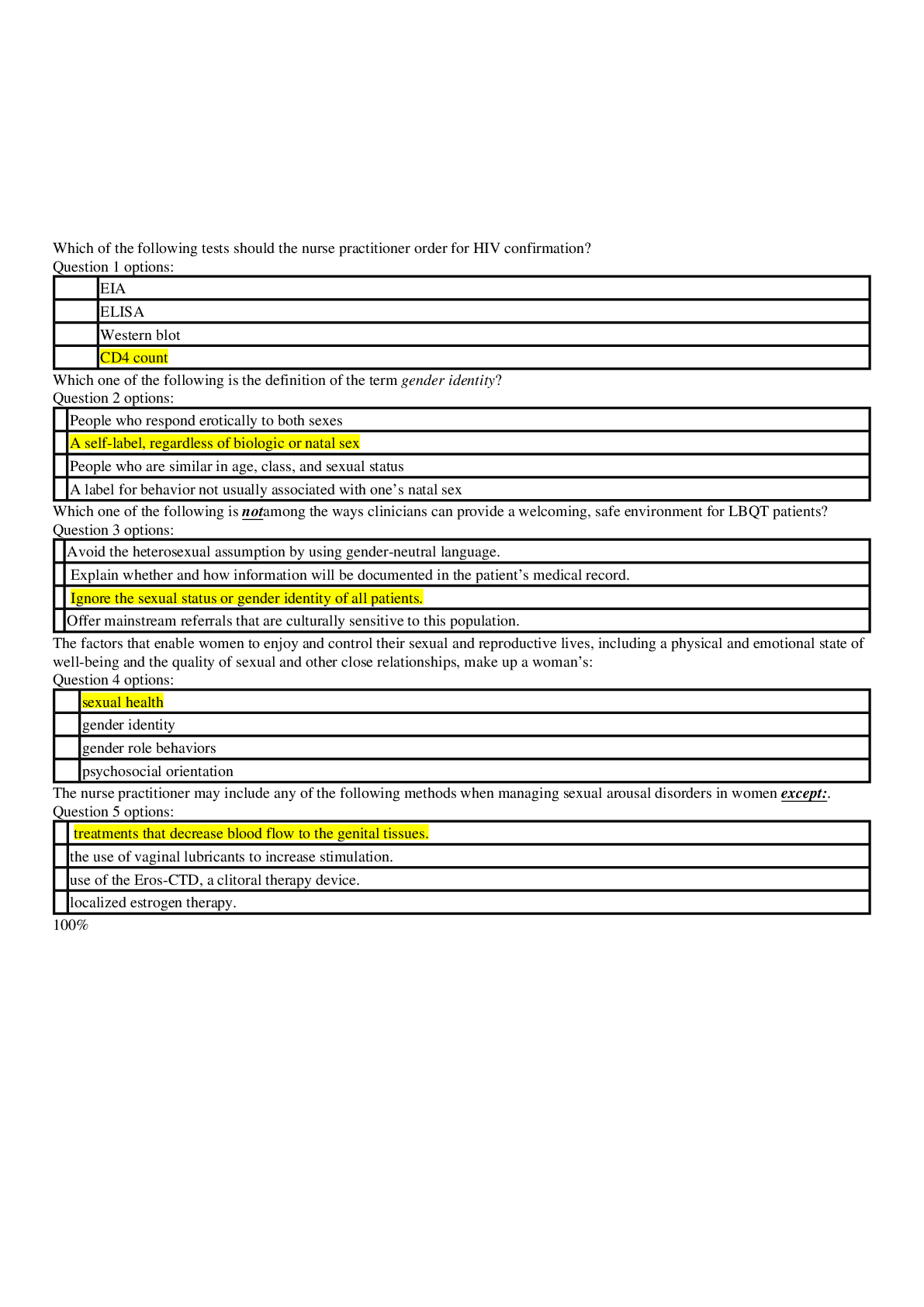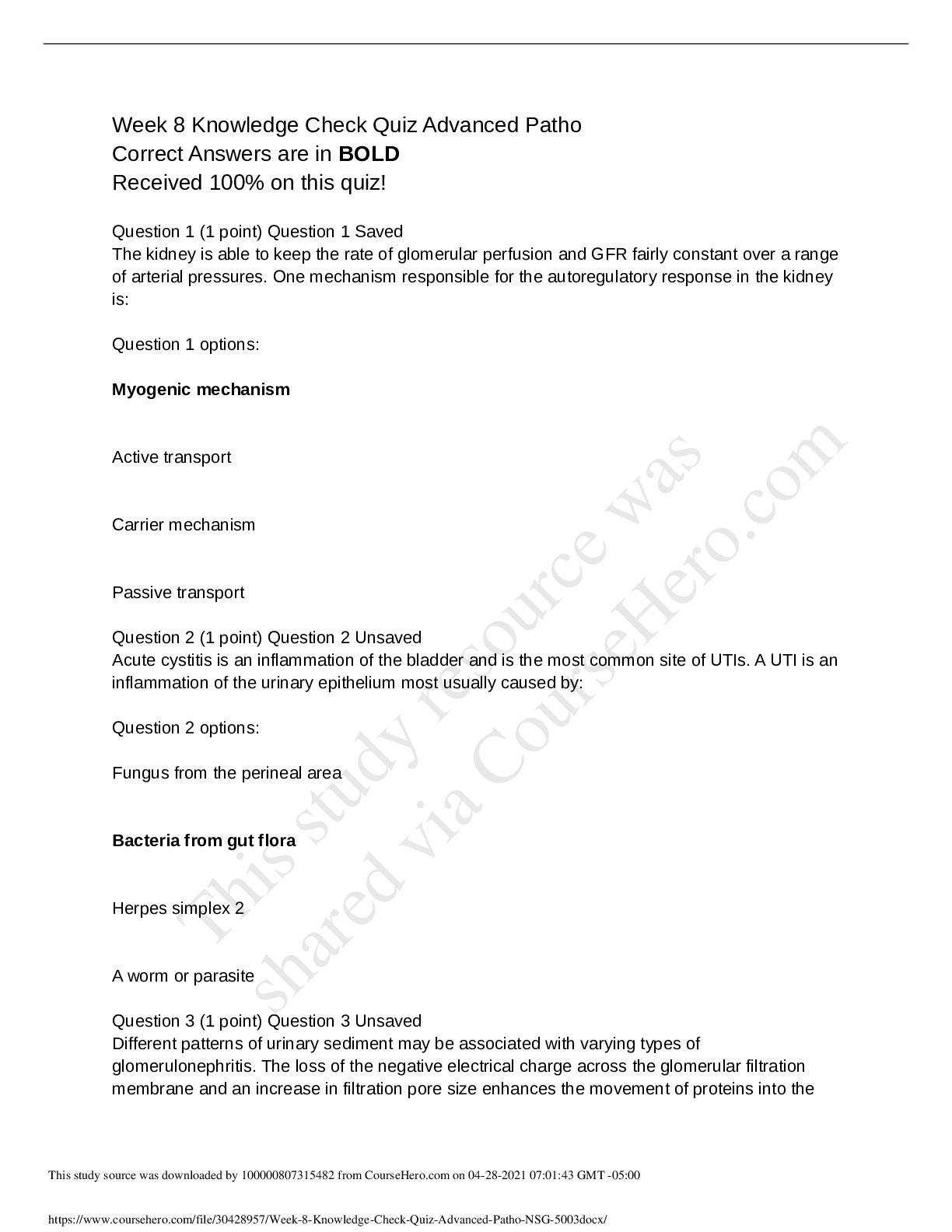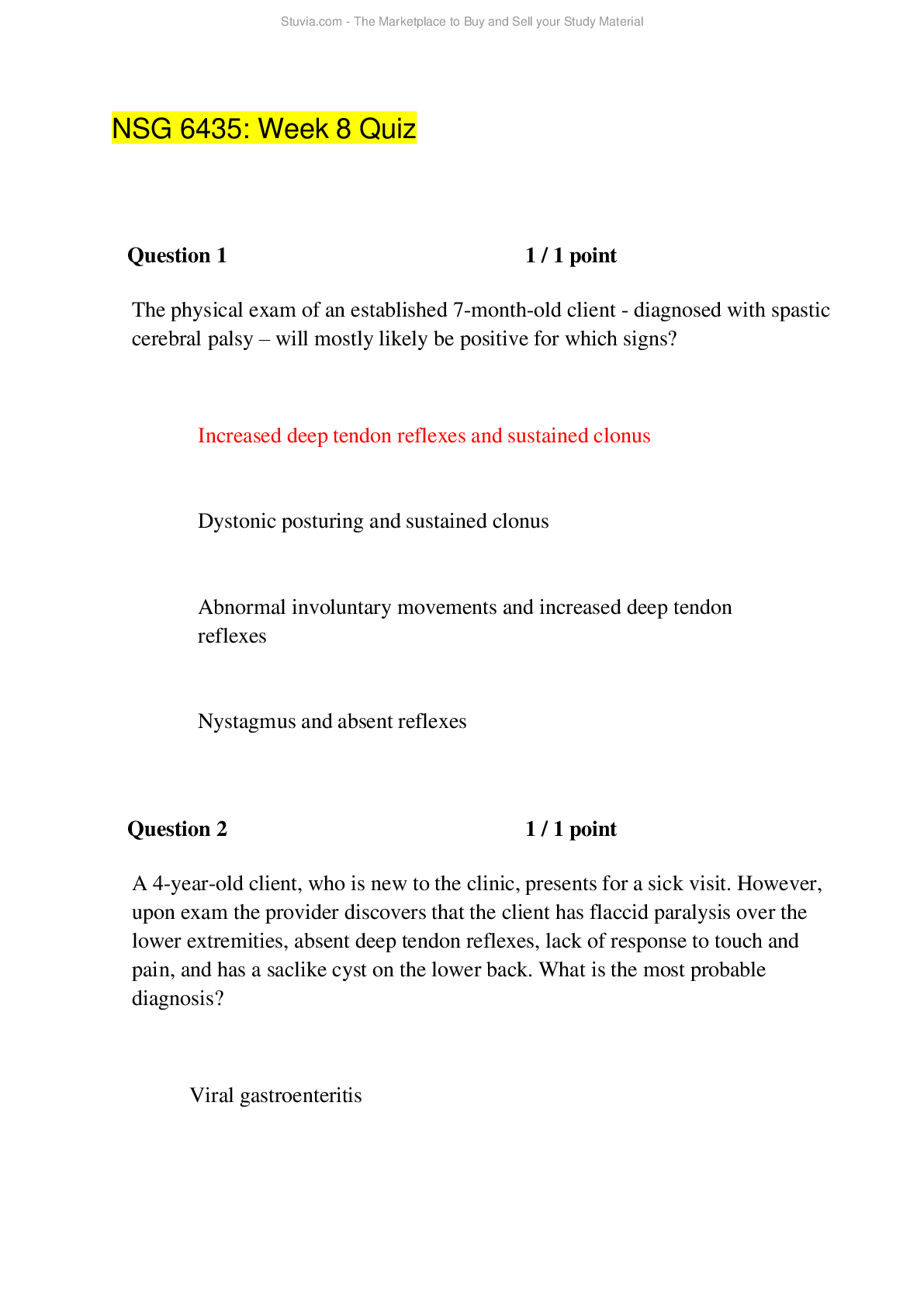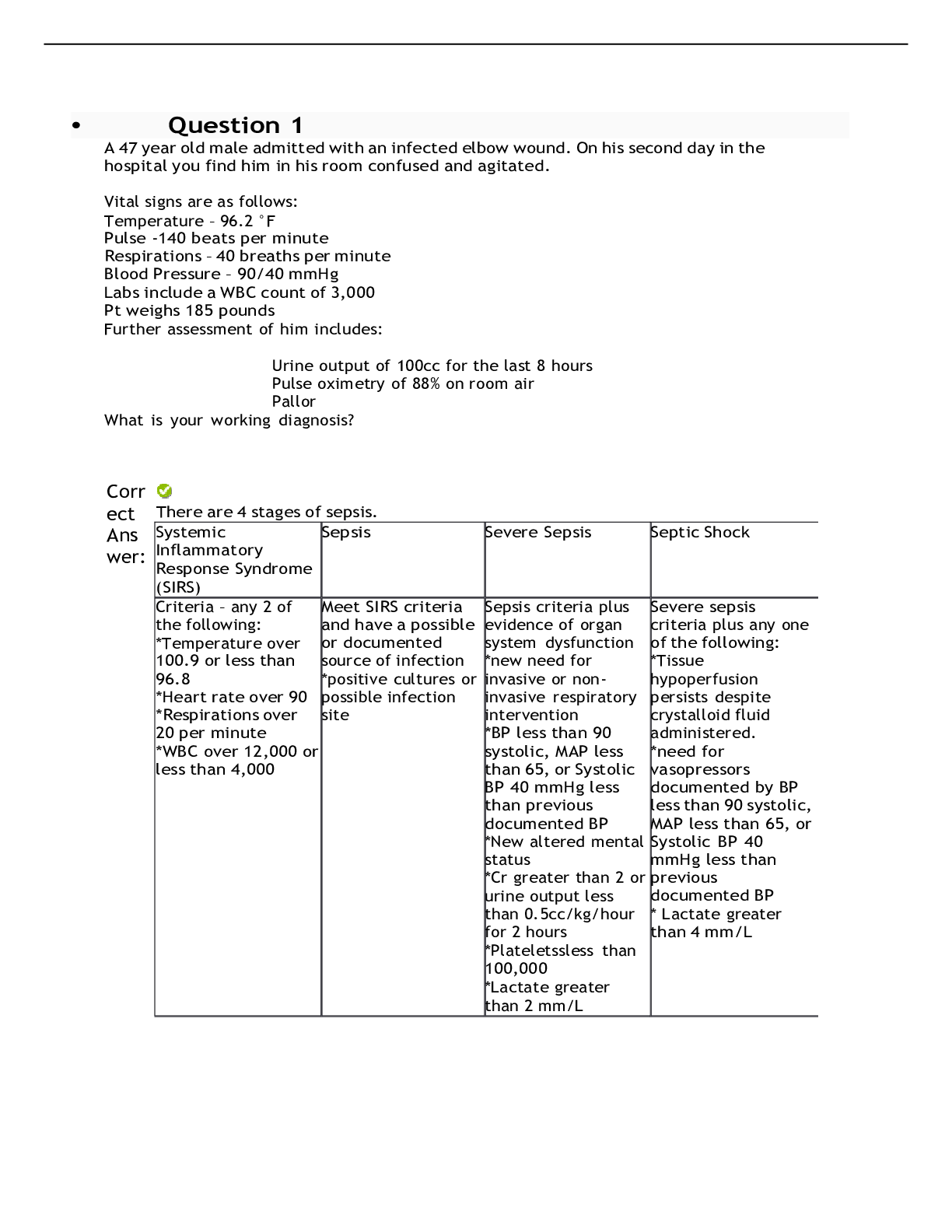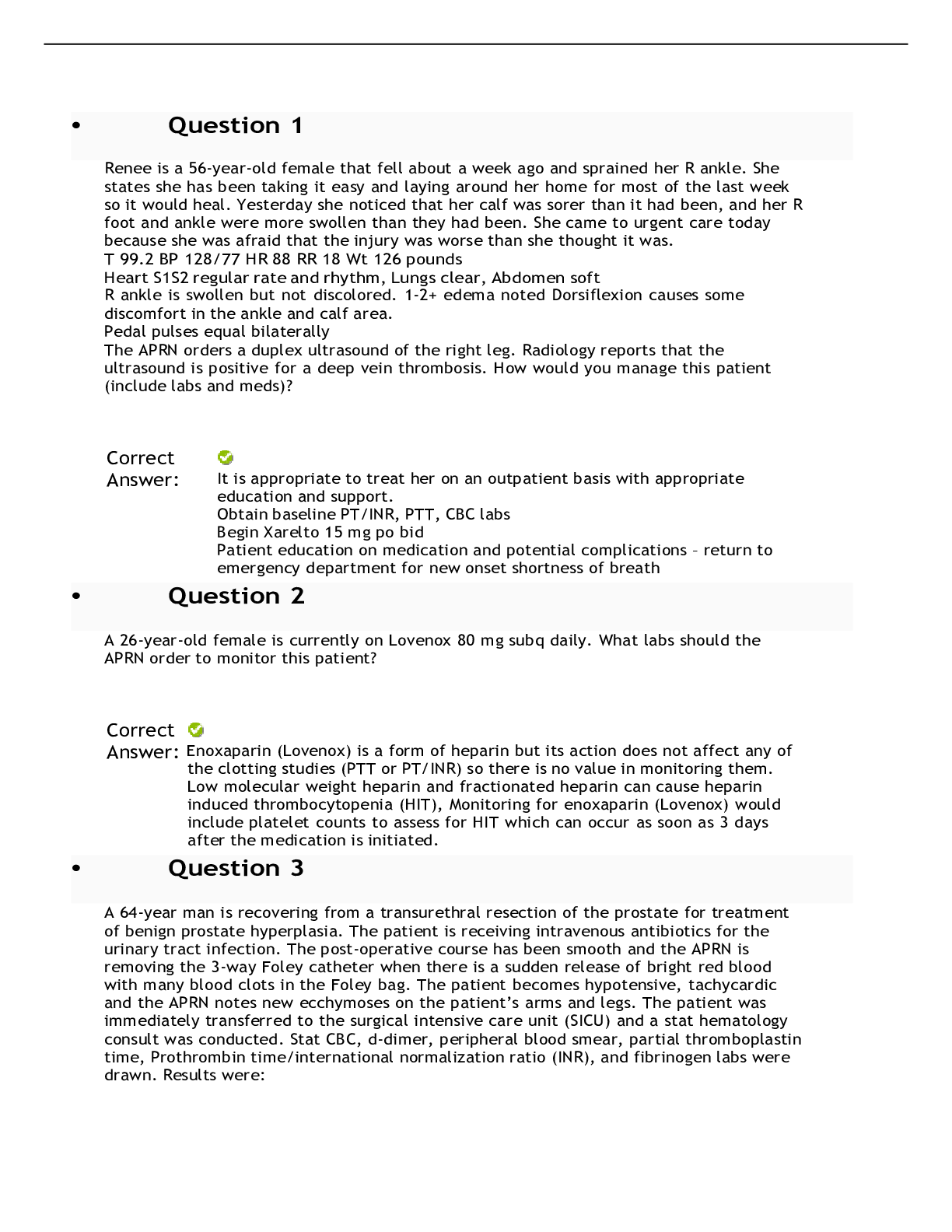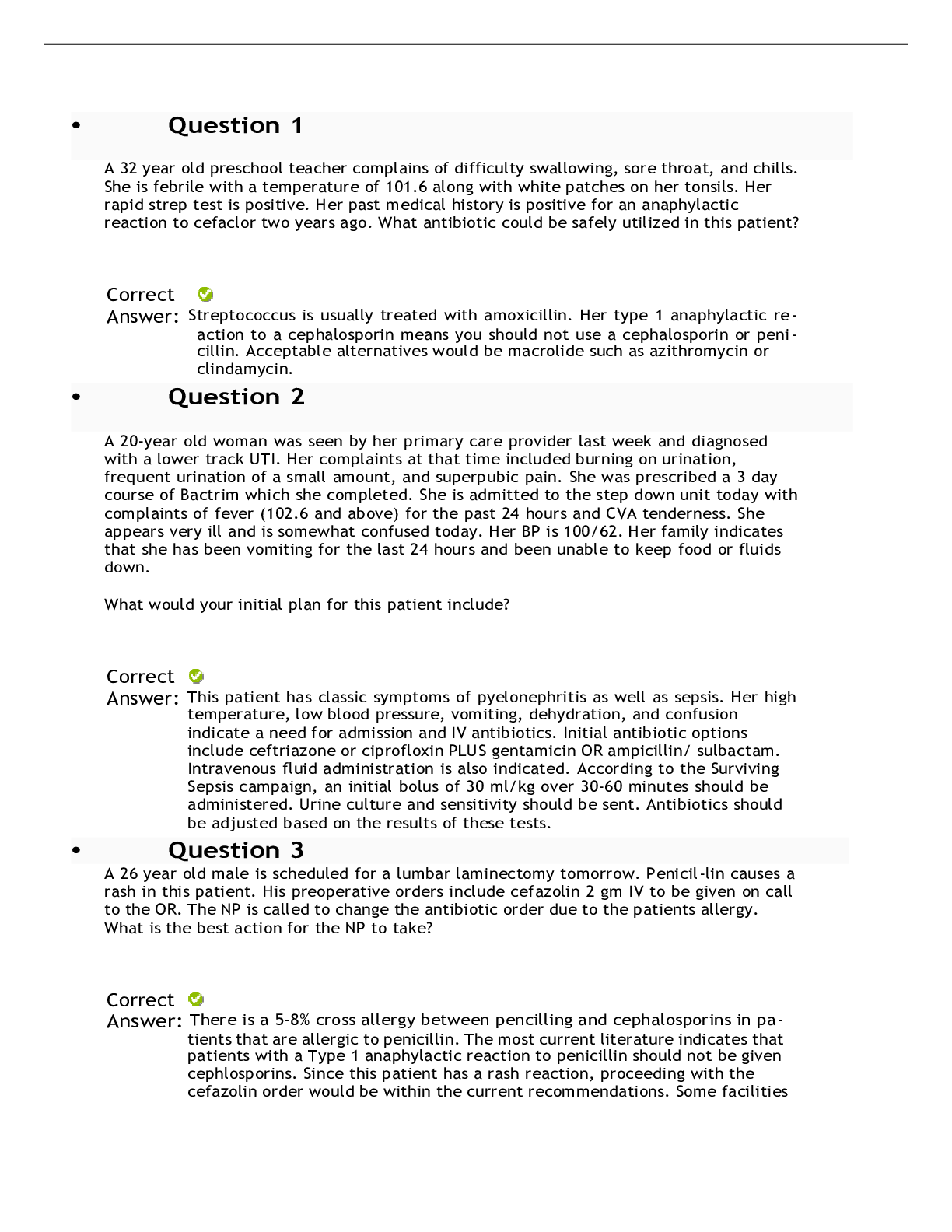*NURSING > QUESTIONS & ANSWERS > NRNP 6566 Week 8 Knowledge Check (100% Correct) Verified Answers (All)
NRNP 6566 Week 8 Knowledge Check (100% Correct) Verified Answers
Document Content and Description Below
What type of ICU sedation would be appropriate for a 32 year old male patient who is intubated with bilateral chest tube following a motor vehicle crash. Correct Answer: The Society of Critical ... Care Medicine publishes a guideline on sedation. It is: Guidelines for the Prevention and Management of Pain, Agitation/Sedation, Delirium, Immobility, and Sleep Disruption in Adult Patients in the ICU (2018). Light sedation is suggested for intubated ICU patients. Non-benzodiazepine sedatives (either propofol or dexmedetomidine) are preferable to benzodiazepine sedatives (either midazolam or lorazepam) in critically ill, mechanically ventilated adults. Describe the levels of sedation (minimal, moderate, deep, general anesthesia, and dissociation) and its affect on consciousness, airway, ventilation, and reflexes. Correct Answer: Sedation decreases a patient’s awareness to the environment and their responses to external stimulation. Sedation occurs a long a continuum which includes minimal, moderate, deep, general anesthesia, and dissociation. Minimal sedation is a drug induced relief of anxiety or apprehension with minimal to no affection on sensorium. Most often this is achieved with an anti- anxiety medication. Moderate sedation causes a depression of consciousness but the patient can still respond to external stimuli. Airway, spontaneous ventilation, and cardiovascular function are maintained. Deep sedation causes a depression of consciousness in which the patient cannot be aroused but responds purposefully to repeated or painful stimuli. Cardiovascular function is maintained but airway and spontaneous ventilation may be compromised. General anesthesia is a state of unconsciousness where the patient is unable to respond to any stimuli. Close monitoring of all airway, ventilation, and cardiovascular function is essential. Dissociation is considered to be a type of moderate sedation that occurs when using medications in the phencyclidine group (such as ketamine). They cause a dissociation of the limbic system preventing higher centers from receiving sensory stimuli. Like moderate sedation, airway reflexes, spontaneous ventilation, and cardiovascular function are all maintained. The APRN has determined that a 21 year old motor vehicle crash victim needs a rapid sequence intubation. The patient weighs 77 kg. What medications are indicated to successfully achieve the rapid sequence intubation? Correct Answer: Rapid sequence intubation requires the use of induction agent to cause unresponsiveness and a neuromuscular blocking agent to cause muscular relaxation. It is the fast and most effective means of controlling the emergency airway. There are no contraindications to using Etomidate and Succinylcholine Etomidate 23 mg IV and Succinylcholine 115 mg IV Here are details about the different medications and their uses. INDUCTION AGENTS Etomidate 0.3mg/kg IV onset: 10-15 seconds Use: good option for most situations including hemodynamically unstable patient. Avoid in sepsis or seizures Can cause adrenal suppression, myoclonus, pain on injection Ketamine Dose: 1.5 mg/kg IV (4mg/kg IM) Onset: 60-90 sec Duration: 10-20 min Use: good option for any RSI,especially if hemodynamically unstable. May be used in TBI (no increase in ICP) and reactive airway disease (causes bronchodilation) Can cause an increase in secretions, caution in hypertension and tachycardia, may cause laryngospasm and increased intra-ocular pressure. Thiopentone Dose: 3-5 mg/kg IV TBW Onset: 30-45 sec Duration: 5-10 min Use: good option in hemodynamically stable patients, also for status epilepticus Causes histamine release, myocardial depression, vasodilation, hypotension Propofol Propofol 1.5-2.5 mg/kg x TBW as the general guide Onset: 15-45 seconds Duration: 5 – 10 minutes Use: should be used in hemodynamically stable patients, appropriate for patients with reactive airways disease or status epilepticus Can cause hypotension, myocardial depression, reduced cerebral perfusion muscular rigidity in high induction doses, bradycardia, tissue saturation at high doses PARALYTIC AGENTS Suxamethonium (aka succinylcholine) Dose: 1.5 mg/kg IV (2 mg/kg IV if myasthenia gravis) and 4 mg/kg IM (in extremities) Onset: 45-60 seconds Duration: 6-10 minutes Use: widely used unless contra-indicated; ideal if need to extubate rapidly following an elective procedure or to assess neurology in an intubated patient Drawbacks: numerous contra-indications (hyperkalemia, malignant hyperthermia, >5d after burns/ crush injury/ neuromuscular disorder), bradycardia (esp after repeat doses), hyperkalemia, fasciculations, elevated intra-ocular pressure, will not wear off fast enough to prevent harm in CICV situations Rocuronium Dose: 1.2 mg/kg IV IBW Onset: 60 seconds Use: can be used for any RSI unless contra-indication or require rapid recovery for extubation after elective procedure or neurological assessment; ensures persistent ideal conditions in CICV situation (i.e. immobile patient for cricothyroidotomy) – can be reversed by sugammadex Drawbacks: allergy (Rare) A 66 year old women in the ICU is diagnosed with delirium. What would be the best approach to treating her delirium? Correct Answer: Delirium is common in critically ill adults. Delirium is a clinical diagnosis which can be detected with some screening tools such as the Confusion Assessment Method for the ICU (CAM-ICU) or the Intensive Care Delirium Screening Checklist. Guidelines for the Prevention and Management of Pain, Agitation/Sedation, Delirium, Immobility, and Sleep Disruption in Adult Patients in the ICU (2018) by the Society of Critical Care Medicine recommends a muticomponent, nonpharmacologic intervention focused on reducing modifiable risk factors. These interventions include reorientation, cognitive stimulation, use of clocks, improved sleep, reduced sedation, early rehabilitation and mobilization, use of hearing aids and eye glasses. Haloperidol is not routinely recommended and studies have not shown that it shortens the duration of the delirium. However, short term use of haloperidol or an atypical antipsychotic may be warranted for those patients who experience significant distress, agitation, or physical risk to themselves or others. The NP is beginning to repair a laceration on a 22 year old female. The patient mentions that she is allergic to lidocaine. What medication would be an appropriate alternative for this patient? Correct Answer: Local anesthetics include two classes of medications that include esters and amides. Lidocaine and bupivacaine are amide anesthetics. In this patient, an ester anesthetics should be utilized. Procaine is an example of an ester local anesthetic. A 54 year old 112 kg women is admitted for incision and drainage of a left renal abscess. She needs TID wet to dry dressing changes that are very painful. She rates the pain during the dressing change as a 10 and describes in as sharp, pulling, and burning. Prior to the last dressing change she received 2 mg of morphine IV which was totally ineffective in relieving any pain of the dressing change. How would you manage the medication dosing prior to the next dressing change? Correct Answer: Recommended IV morphine dosing is 0.05 to 0.1 mg/ kg. Based on her weight, the recommend-ed dose would be 6-12 mg IV every 1-2 hours. Since 2 mg was ineffective, it would be reasonable to increase the next dose to 6 mg IV 20 minutes prior to the dressing change. Assess her response to this dose increase and [Show More]
Last updated: 1 year ago
Preview 1 out of 5 pages
Instant download
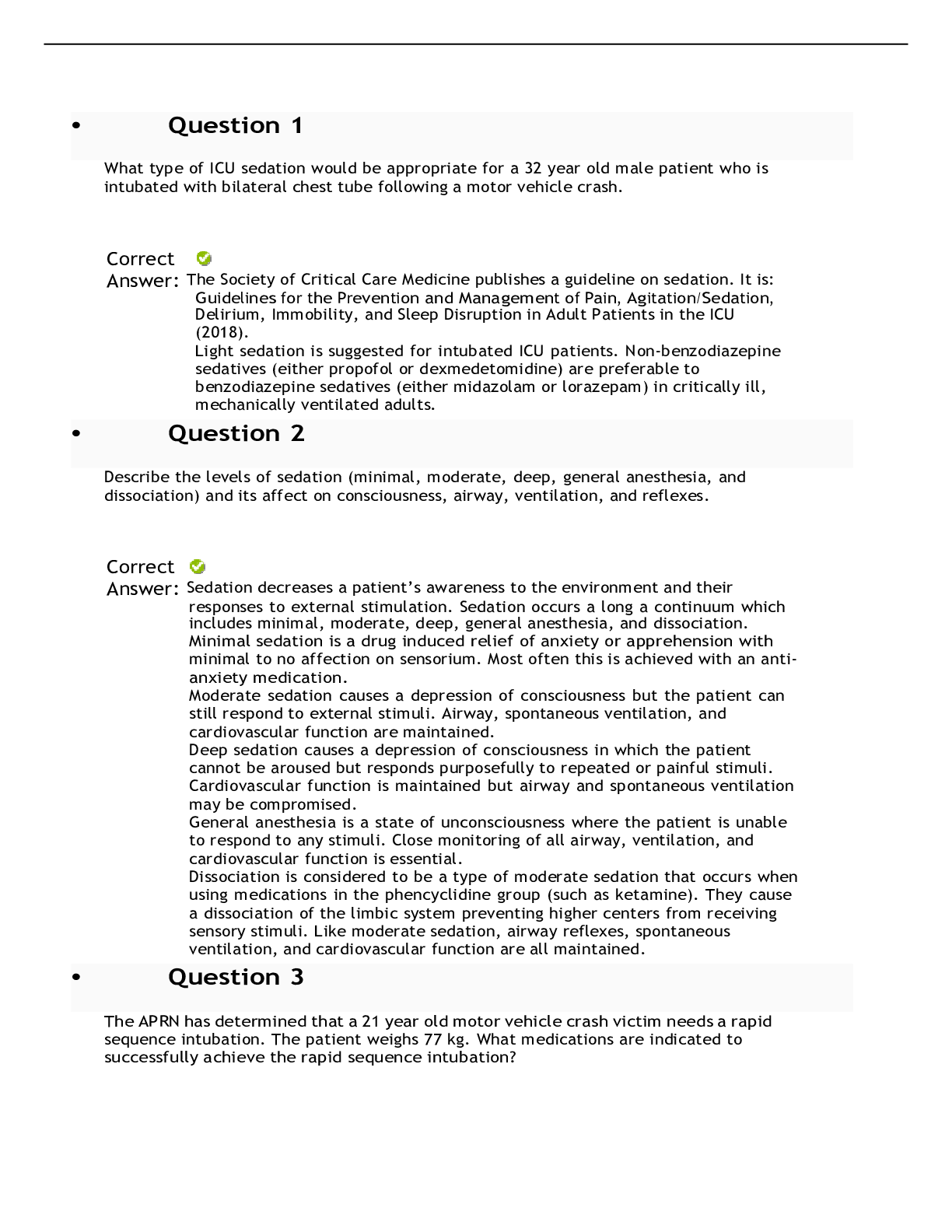
Buy this document to get the full access instantly
Instant Download Access after purchase
Add to cartInstant download
Reviews( 0 )
Document information
Connected school, study & course
About the document
Uploaded On
Nov 18, 2021
Number of pages
5
Written in
Additional information
This document has been written for:
Uploaded
Nov 18, 2021
Downloads
0
Views
80
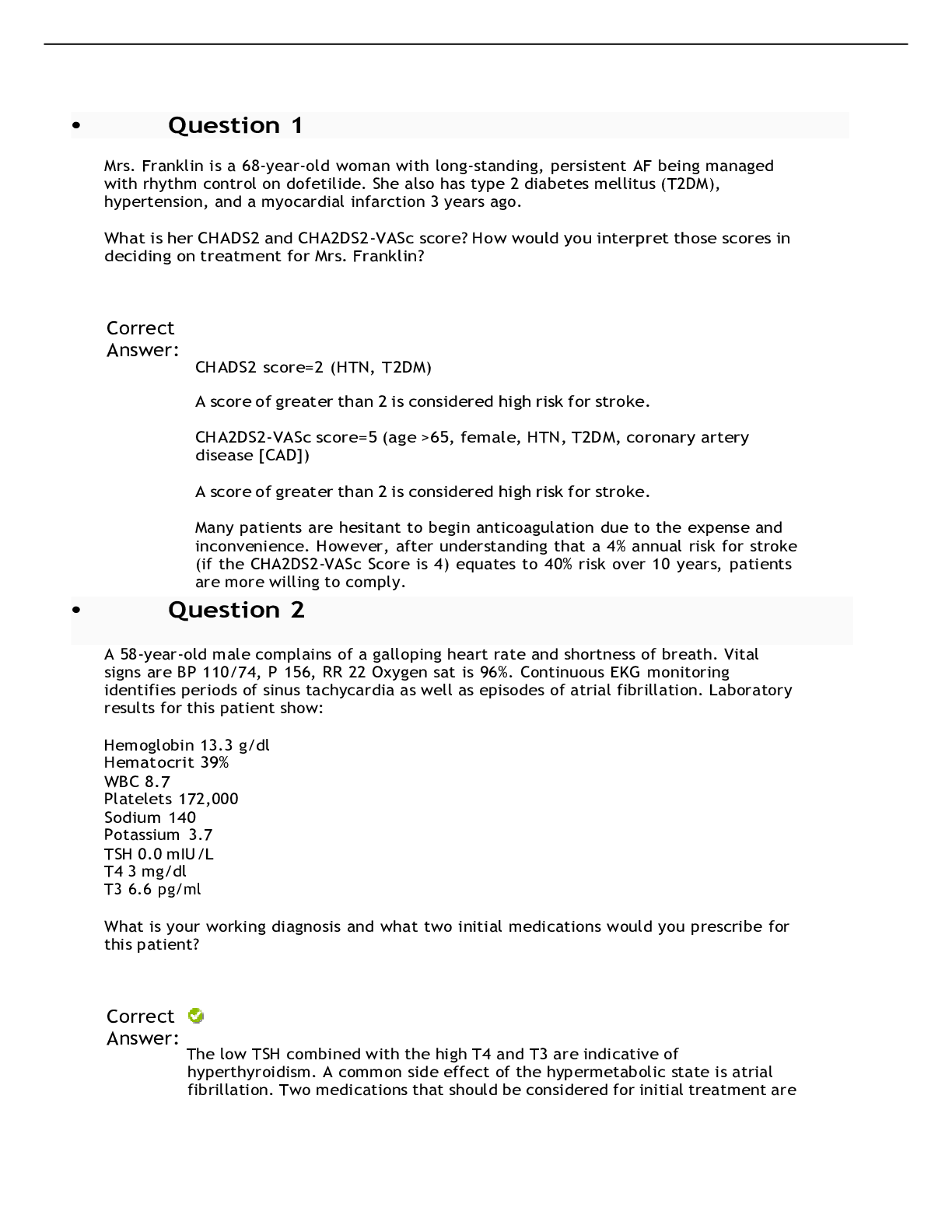

.png)
.png)
.png)
.png)
.png)
.png)
.png)
.png)
.png)
.png)
.png)




